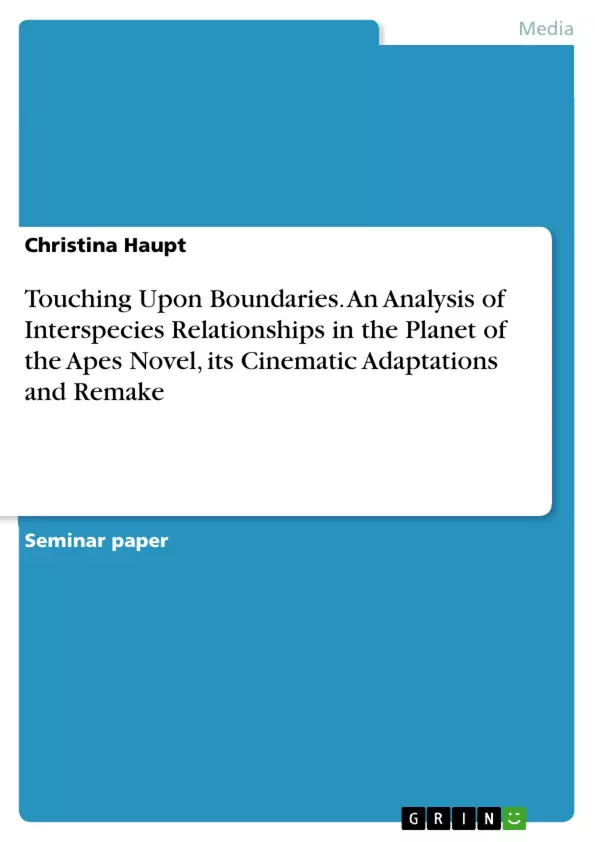“To linken human beings to beasts is to stress the animal within the man” (Jordan qtd. in Greene 50).This statement gets to the heart of the discussion about the relationship between apes and human beings in Pierre Boulle’s French novel La Planète des Singes/Planet of the Apes , its first U.S.-American cinematic adaptation by director Franklin J. Schaffner and the homonymous U.S.-remake of 2001. Despite the texts’ vast variety of discourses, of which most have been discussed extensively in the academic field, it is the aim of the present paper to focus solely on the question of how the relationship between the ape and human species is presented in PotA (1963), PotA (1968) and PotA (2001) with regard to the construction and challenging of limitations. The aim is to demonstrate that, despite the persistence of interspecies boundaries, the texts clearly progress in bringing the species closer together.
In recent years, the rising awareness of human beings’ close kinship to other primates as well as the ongoing extinction of species2 have made it more relevant than ever before to study and, thus, preserve biodiversity of apes. The three texts mentioned above contribute to an understanding of the development of human-ape kinship over the past decades by illustrating “the human in the animal and the animal in the human” (Balaschak 20) in unique ways.
The paper’s approach is to, firstly, embed the texts in their historical and cultural environment by considering the impact of primatology and contemporary socio-political conflicts on the representation of the ape-human relationship. Then, attention is given tomeans of separating the species through the construction of intra- and interspecies hierarchies and the use of language to justify speciesism in the novel, its adaptation and the remake. This exploration is followed by an analysis of how these boundaries are challenged by taking a closer look at the respective interspecies relationships between the male human protagonist and the female chimpanzee lead. Ultimately, the paper closes with a summary of the results
and, additionally, gives a brief outlook into the possible future direction of the ape-human evolution and impulses for further research.
Inhaltsverzeichnis (Table of Contents)
- Introduction
- Embedding the Texts: Historical and Cultural Frame
- The Rise of Primatology
- Addressing Contemporary Issues by Juxtaposing Ape and Human
- Means of Separation
- Intra- and Interspecies Hierarchies
- Planet of the Apes (1963)
- Planet of the Apes (1968)
- Planet of the Apes (2001)
- The Use of Language to Justify Speciesism
- Planet of the Apes (1963)
- Planet of the Apes (1968)
- Planet of the Apes (2001)
- Intra- and Interspecies Hierarchies
- Blurring Boundaries: Interspecies Connections
- Ulysse and Zira (1963)
- Taylor and Zira (1968)
- Leo and Ari (2001)
- Conclusion
Zielsetzung und Themenschwerpunkte (Objectives and Key Themes)
This paper explores the representation of the relationship between apes and humans in Pierre Boulle's novel *La Planète des Singes/Planet of the Apes* (1963), its cinematic adaptation *Planet of the Apes* (1968), and its 2001 remake. The paper analyzes the construction and challenging of limitations between the two species, focusing on how the texts depict their evolving kinship. The paper's goal is to demonstrate that, despite the persistence of interspecies boundaries, these texts move towards a greater understanding and connection between humans and apes.
- The impact of primatology and contemporary socio-political conflicts on the representation of the ape-human relationship
- The construction of intra- and interspecies hierarchies and the use of language to justify speciesism
- The challenging of interspecies boundaries through the exploration of specific interspecies relationships between the male human protagonist and the female chimpanzee lead
- The potential future direction of the ape-human evolution and impulses for further research
Zusammenfassung der Kapitel (Chapter Summaries)
The introduction contextualizes the analysis by highlighting the increasing relevance of studying and preserving ape biodiversity in light of human-ape kinship and species extinction. The paper then explores the historical and cultural context of the texts, examining the influence of primatology and contemporary issues on their depiction of the ape-human relationship. The analysis proceeds to investigate the various means of separation between the species, including the creation of hierarchies and the use of language to justify speciesism, as seen in the novel, its adaptation, and the remake. This section examines how these boundaries are constructed and maintained in each text.
Schlüsselwörter (Keywords)
The key terms and concepts explored in this paper include: interspecies relationships, speciesism, primatology, biodiversity, ape-human kinship, intra- and interspecies hierarchies, language and communication, and the portrayal of ape-human interactions in literature and film.
- Quote paper
- Christina Haupt (Author), 2019, Touching Upon Boundaries. An Analysis of Interspecies Relationships in the Planet of the Apes Novel, its Cinematic Adaptations and Remake, Munich, GRIN Verlag, https://www.grin.com/document/511967



